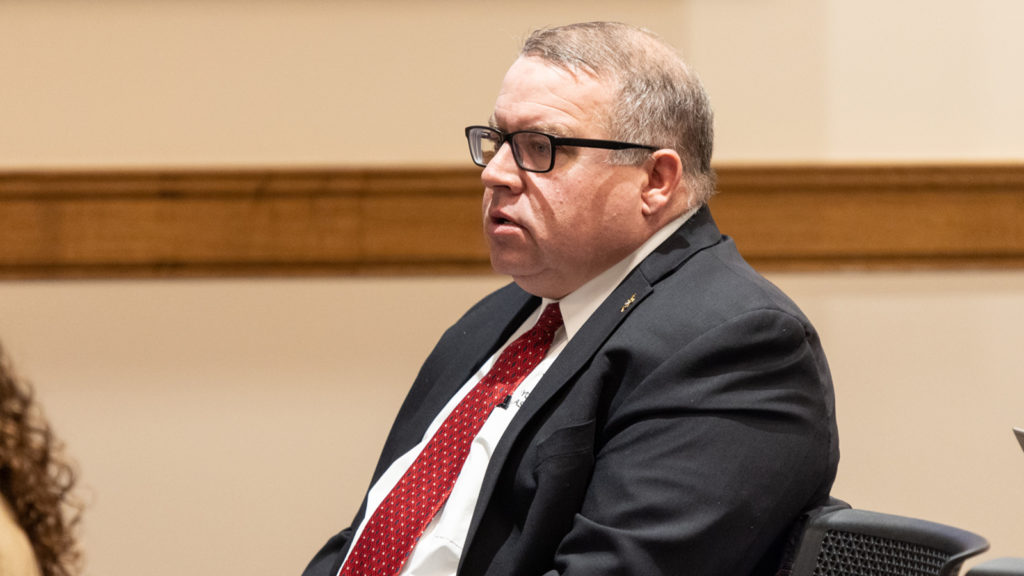By Kevin Killough, State Energy Reporter
Kevin@CowboyStateDaily.Com
Wyoming coal mines saw an uptick in production last year, but about 50 million tons of production didn’t happen because of a lack of rail service to get the coal from the mines in Wyoming to power plants across the country.
During a presentation for the Senate Minerals, Business and Economic Development Committee this week, Wyoming Mining Association Executive Director Travis Deti said that when mines can’t ship coal, it’s just lost business.
Mines don’t get paid until the coal leaves, which means that if it can’t leave the mine, they have to stop producing coal.
“The utilities expect to burn it on certain days, so it’s lost production,” Deti said.
He estimates that the state of Wyoming lost about $100 million in revenues as a result of unrealized severance taxes from that lost production in 2022.
In December, during the Arctic blast that sent temperatures rapidly into negative numbers in a matter of hours, Wyoming mines had consecutive days in which no rail cars were available.
Deti told Cowboy State Daily that one of Wyoming’s coal companies told him recently that when it comes to getting rail service, it’s “hit or miss.”

Hit To Consumers
When coal-fired power plants can’t get coal, they switch to natural gas, Deti said.
During periods of cold weather, natural gas prices tend to go up, and so when plants are using more gas, it costs more for consumers.
“That’s what we’re seeing across the country, is power bills are really spiking right now because we can’t get enough coal to the utilities,” Deti said.
Not Just Coal Impacted
Deti added that it’s not just Wyoming mining commodities that are encountering a problem with rail service.
“Ag producers are also having issues getting rail service,” he said.
Wyoming mines are served by Union Pacific and BNSF Railway, and neither company responded to Cowboy State Daily requests for comment.
Randall Luthi, energy advisor for Gov. Mark Gordon, told Cowboy State Daily that the governor had spoken to both companies and was told the problem is a labor issue. The companies don’t have crews to drive or maintain the trains.
“The governor is very concerned about it. So, he kept the pressure up … and encouraged them to do whatever they can do to make sure they’ve got the train and crews necessary to move forward,” Luthi said.
Terrible Performance
During Arch Resources’ third quarter 2022 earnings call in October, Paul Lang, president and CEO, mentioned the impacts of rail service to its Black Thunder and Coal Creek mines near Gillette.
“We’ve had one of the railroads just have terrible performance. And unfortunately, we’re heavily weighted to that railroad. And it’s been difficult, and it’s cost us a lot of money this year,” Lang said.
Peabody Energy, which runs the Caballo, North Antelope Rochelle and Rawhide mines — all in the Powder River Basin in northeast Wyoming — is facing the same logistical challenges.
Jim Grech, Peabody CEO, said during its third quarter 2022 earnings call in November that the situation had improved somewhat during the third quarter.
Still Breathing
In his presentation to the committee, Deti said that Wyoming coal mines produced an estimated 247 million tons last year, which was an increase of 10 million tons over 2021.
“The reports of our death are greatly exaggerated,” he said.
With all the rail capacity needed, the mines could have produced nearly 300 million tons.
That’s down from the 460 million tons in 2008, but it’s been a good year for coal, Deti said. It also would’ve been the most coal the PRB had produced since 2017’s 305 million tons.
Wyoming supplies about 80% of the nation’s thermal coal, which powers about 25% of the total U.S. electrical generation.
In Wyoming, there’s a reserve of about 162 billion tons, which is the amount of coal that can be accessed now with existing technology. That translates to 645 years of energy. There’s another 1.4 trillion tons that can be produced with improved technology.
“The resource is vast,” Deti said.
Coal Steps Up
Deti said that it’s unlikely that Wyoming coal production will ever return to the 400 million tons it was 15 years ago, but it’s still needed to produce reliable, affordable electricity.
In February 2021, winter storm Uri dumped record snow and frigid temperatures on Texas.
About 200 people are estimated to have died as a result of the cold. Natural gas supplies were stretched thin, and there wasn’t enough wind to produce much wind energy.
Coal-fired generation, Deti said, was brought online to provide some energy to the frozen state.
“Two hundred people died in Texas a couple years ago because of an over-reliance on unreliable sources of power. Coal had to step up,” Deti said.
Deti talked about research at the University of Wyoming School of Energy Resources that’s developing new uses for carbon construction products made from coal, as well as carbon capture technologies that can help reduce coal’s carbon dioxide emissions.
Deti also addressed what he called “pearl clutching” reports about Rocky Mountain Power requesting the Wyoming Public Service Commission allow it to increase rates to pay for carbon capture.
“It’s going to raise your rates by 0.3% for ratepayers to implement carbon capture,” he said. “That, to me, sounds like a pretty good value.”





